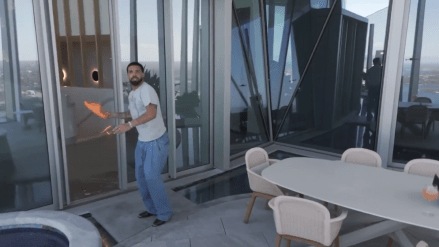Drake recently became the centre of attention when a video surfaced of him attempting to hit a drone with a slipper in his luxury Sydney penthouse. The footage, which quickly went viral on social media, shows the rapper entering his apartment, surprised to find a drone hovering near his desk. He reaches for an orange slide and throws it at the drone, but misses as the device flies away, capturing the sky outside.
While the clip seems dramatic, many fans on social media have pointed out that the scene might have been staged for promotional purposes. Speculation arose due to the visible gambling site on the laptop screen in the video, which led some viewers to believe the incident was part of an ad for Stake, a betting company Drake is associated with. One comment even mentioned the apparent reflection of a drone operator, further fueling claims that the stunt was scripted.
Despite the growing doubts about the video’s authenticity, the clip sparked a range of humorous reactions. Some fans joked about Drake’s aim, comparing his slipper toss to a mother trying to fight off a spider, while others made light-hearted remarks about his “anime grunt” as he threw the slide.
This drone incident comes on the heels of Drake’s ongoing tour in Australia. The rapper is currently performing in Sydney as part of his “Anita Max Win Tour,” where he recently made headlines for helping a fan quit their McDonald’s job. During a concert, Drake noticed a sign in the crowd reading, “Help us quit Maccas,” referring to McDonald’s by its popular Australian nickname. In a lighthearted moment, he addressed the fan and jokingly adopted an Australian accent, much to the crowd’s delight.
Whether the drone video was a marketing ploy or simply a quirky moment in Drake’s life, it’s clear that the rapper continues to find himself in the spotlight, both for his music and for unexpected moments like this. In recent years, brands have increasingly turned to negative or speculative PR strategies to generate buzz and capture public attention. A notable example of this was when Duolingo announced the “death” of their mascot, Duo the Owl, a move that sparked curiosity and conversation on social media, ultimately increasing engagement. Such tactics create an air of mystery, leaving people intrigued and eager to know more. This trend of negative PR has proven effective in drawing attention, with brands turning seemingly controversial or provocative actions into viral marketing campaigns. Another example is Puma’s recent renaming of itself to “PVMA” for a collaboration with Indian badminton star PV Sindhu. While the bold move garnered significant attention, it’s worth considering whether this was a calculated stunt to tap into the buzz around the athlete. Negative or speculative PR, while sometimes polarising, can be an effective way for brands to stay in the spotlight and provoke conversations that drive their marketing efforts.
